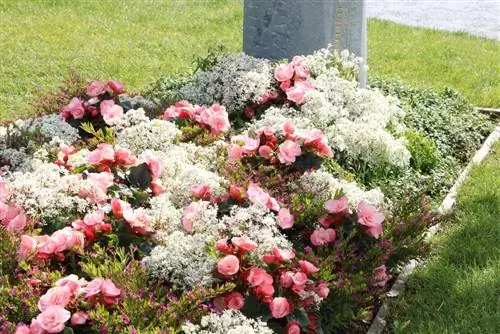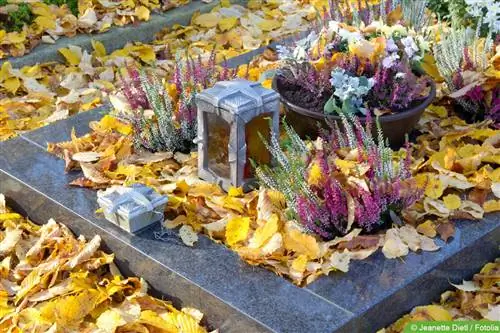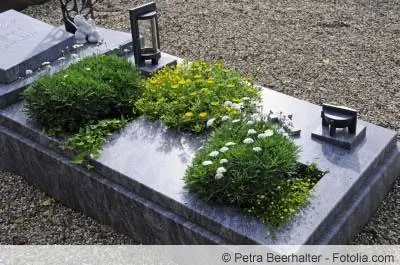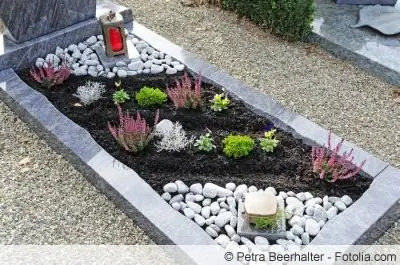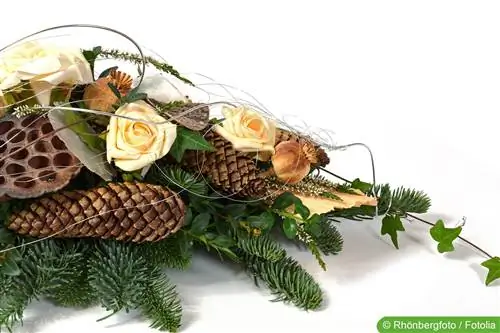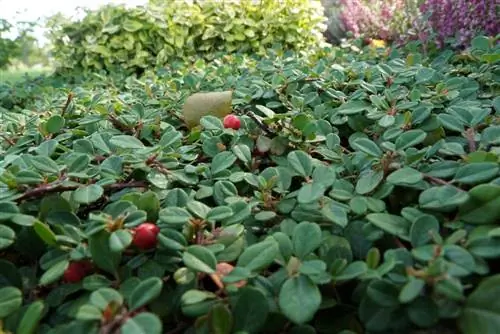- Author admin [email protected].
- Public 2023-12-17 03:39.
- Last modified 2025-01-24 12:45.
In order to make a grave design for the summer sensible, beautiful and yet easy to care for, it is recommended to cover it with greenery. If possible with one basic planting, one type of plant. This has the advantage that in summer the earth surface of the grave remains moist for as long as possible and at the same time it prevents the earth from being washed away. A nice alternative to traditional summer plantings on graves is a perennial. For example, a heart flower or also called a bleeding heart. The correct name is Dicentra spectabilis, it is a perennial herb and loves light shade or partial shade. The girl's eye (Coreopsis) blooms from early summer to autumn and also enchants visitors on graves. However, she loves it sunny. After the first flowering, it is advisable to cut it back, so it will continue to bloom and bloom almost inexhaustibly.
Plants for the basis of the grave design
The girl's eye is a beautiful example of a frugal ground cover that continues to decorate graves near the ground from June to August, but there are a few other undemanding flowering plants that are ideal for grave design: also sunny ones The flowers of the yellow elf flower produce colors; this elf flower of the “Frohnleiten” variety is the only one that can really be recommended as a ground cover. It also grows in the shade and also helps you fight weeds with its tough and closely spaced roots. The carpet golden strawberry does not decorate the ground with any yellow flowers in spring and otherwise quickly forms a dense blanket on the grave with its runners, even in very shady locations. The soil should provide some nutrition, otherwise the perennial, also known as Waldsteinia, has few requirements. Balkan cranesbill and spotted lungwort are also robust enough for a location that is not constantly maintained and develop flowers in spring in delicate pink, red or purple, and lungwort also provides extensive foliage decoration, as the name suggests. The small-leaved periwinkle is much more subtle in its choice of colors; you can choose between delicate blue or white flowers. The evergreen subshrub thrives in relatively loose and nutrient-rich soil, continues to spread via ground shoots and blooms from May to September.
The ground cover for the grave can also be kept completely natural: Ivy is a classic for grave design, and rightly so: it is strong-growing and evergreen, and you can spread it as a ground cover and let it climb up any supports. Well-hardy varieties, e.g. B. “Lake Balaton” do best on the grave, ivy actually grows on any soil and is otherwise quite undemanding. A very decorative ground cover is the hazel root, which also brings some shine to the surface with its dark green leaves. However, it wants partial shade and shade, so it can easily be planted as a base under other trees. The Ysander, popularly also known as fat man or shadow green, forms beautiful and closed green blankets that do not allow any other plants to pass through. Ysander needs a normally nutrient-rich soil and tolerates almost anything, even a cover of autumn leaves, but it can easily take issue with soil that is too acidic. The variety “Green Carpet” is particularly suitable for grave coverings as it only grows up to 20 cm high and is extremely frost hardy.
Or should it be a special surface decoration? The evergreen creeping spindle is your plant of choice if you want to add color to the grave design through the ground cover: It has multi-colored leaves, even in different varieties, you can choose between green-white (the “Emerald Gaiety” variety) and green-yellow (“Emerald Gold”), both turn red or reddish in winter. The creeping spindle is not demanding, but if it gets a lot of sun, the colors develop more beautifully. The foam flower is a frugal underplanting that forms a dense cover with its runners, but does not put pressure on the roots of the bushes above it, which react harshly to competition. You can e.g. B. can be planted very well under rhododendrons, which are sensitive in this respect, and it can also withstand all the other autumnal masses of leaves that fall on them. From May onwards it covers the area with many tiny white flowers, which last until early summer.
Durable and decorative grave design with bushes
All of these ground cover plants are also an effective protection for the earth's surface and form a durable and decorative basis on which you can now plant taller plants for grave design:
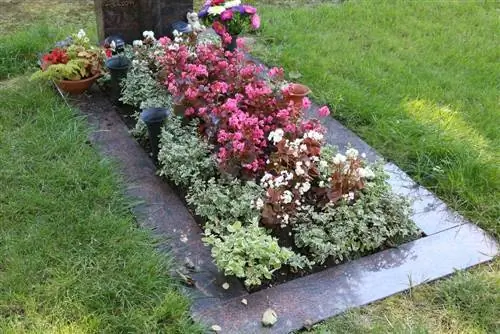
The bleeding heart mentioned above is just one of the many perennial plants that can develop into a truly magnificent bush as individual plants on a grave. All kinds of roses are also very popular as permanent grave decorations, although they are not necessarily pruned every year. If the roses are allowed to grow as they like, the rose bush will become wild again over time. Many people like such a rose bush very much, it undoubtedly looks very romantic.
If the soil in the cemetery is permanently enriched with the shedding of various coniferous trees there, it will most likely be acidic enough to provide really good conditions for a rhododendron. If you really want to plant a rhododendron, but the soil in the cemetery is not acidic enough: There are now rhododendron cultivars that even like calcareous soil.
These are just examples, as already mentioned, which shrubs you choose for the grave design depends on the entire environment. Within the constraints of the ambience, you will definitely still have several types of shrubs to choose from. Maybe you can choose these with your children and tell them something about the deceased? Then you will probably have a much better chance if you later want to ask your children for help with grave maintenance.

